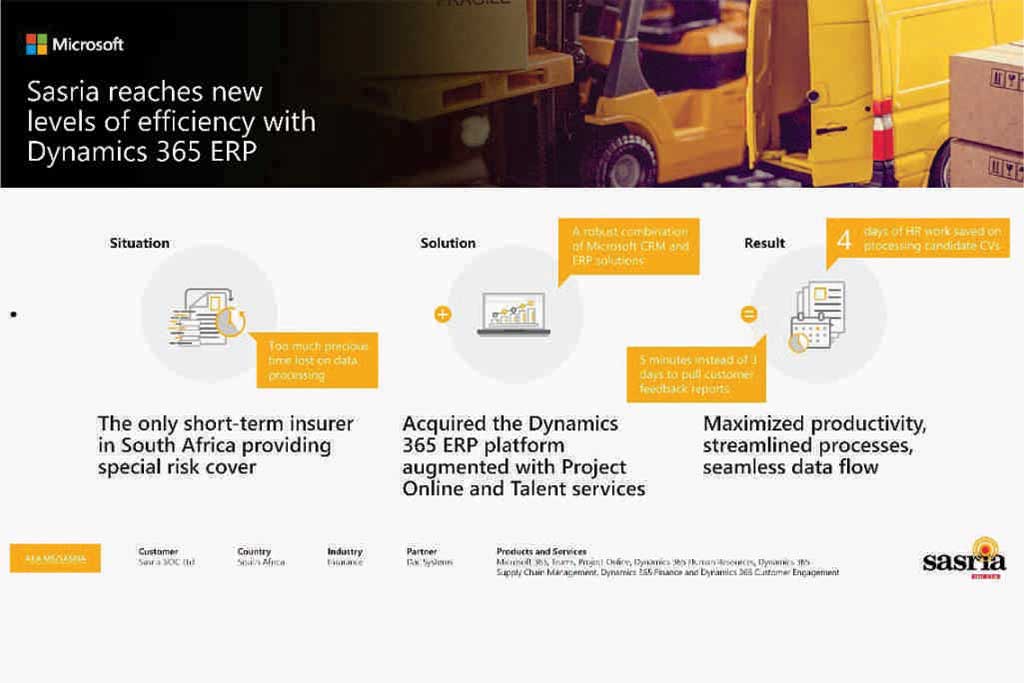The insurance market is fraught with challenges, brought on by digital disruption, climate change, and demographic transformations. To navigate securely across the sector’s shifting waters, industry leaders like Sasria SOC need a clear line of sight into its data and processes. In the move to streamline operations, gain business insight, and empower the workforce, the company partnered with DAC Systems and went live with Microsoft Dynamics 365 ERP deployment. By simplifying customer engagements and reducing manual tasks, the solution freed up Sasria’s teams to perform more value-added work.
“Our transformation started in 2017, when we developed a strategic technology plan to enhance mobility and connectivity for both our staff and customers,” says Sam Nkosi, CIO at Sasria. One of the milestones along the insurer’s digital journey was deploying a single modernized platform to consolidate data from disparate systems, and applications.
“Among the systems to reconcile was an insurance management system linked to banks and insurers. Synchronizing information and getting a comprehensive view of these stakeholder requirements was a time-consuming process,” says Mandla Madi, Director at DAC Systems, the Microsoft Gold Certified Systems Integrator in charge of the implementation. “It would take up to three days for the information to work its way through the disparate environment and for analysis to be done.”
Overcoming lockdown
After a close evaluation of several enterprise resource planning (ERP) solutions, the stakeholders resolved to go live with Dynamics 365 ERP, adding to the existing mix of Microsoft services.
“We are 60 percent Microsoft,” explains Nkosi. “So, using a product that was already catered to our environment would ensure an easier adoption than going for a completely new and unfamiliar one.”
When testing and training had to be conducted remotely due to the lockdown Sasria and DAC took advantage of Microsoft Teams to coordinate all tasks over distance and complete the implementation on schedule. “All communication tools: SharePoint, digital signatures, and Microsoft 365, were fully functional, and we had everything in terms of infrastructure ready to move forward as a business,” says Vuyisile Khumalo,Project Manager at Sasria.
A bird’s-eye view of the business
The ERP solution glues all data, systems, and processes together, affording Sasria’s teams the ease of getting information on the fly. “We had three financial systems, where if you added information in one place, you had to wait several hours before it was updated elsewhere,” says Sandile Makhathini, Head of Procurement at Sasria. “With Dynamics 365, we have credible information, and can maintain it in one place.”
Data consolidation has removed misalignments and solved duplicate data entry. “Everyone uses a single source of truth so there’s no duplicate chain of effort,“ explains Thobile Moeketsi, Business Analyst at Sasria. On top of these gains, security and privacy features embedded in the centralized platform have tightened access and data control, taking into account all compliance requirements. “We can guard key documents we don’t want to share with particular groups of people. If there is ever an outgoing email with confidential information that mustn’t be disclosed, our security team will pick it up before it gets sent,” adds Nkosi. “Three years ago, we used to get some phishing complaints. This cloud-based solution has all but removed phishing concerns. We even use AI to automate our defensive efforts so our staff can focus on more strategic projects.“
Reclaiming lost time
In the past, the lack of data integration and coordination impacted employee efficiency and swift decision making. “On the finance side, one of the activities that the organization was spending the most time on was the periodic reporting. People had to pull data from different systems, and then in most instances, they would find out it didn’t match,” notes Moeketsi. Dynamics 365 provided a way to streamline key activities, such as account reconciliation and claims processing. “Dynamics 365 comes with standardized reports, which don’t require us to do anything. You just run a report, and it gives you all the information you need to support the decisions you have to make.”
Today, users no longer have to monitor purchase orders and payments; all reconciliation is automated and available via a single system. “We even have the integration with banks to see bank statements. We can pull the data through, and check which transactions are not in our system, and which ones do not match the bank statements,” says Moeketsi.
Aligning people with data and processes
The transformation has permeated all aspects of Sasria’s operations—one of its greatest beneficiaries being the HR and customer relationship teams. The combined Microsoft Project Online and Dynamics 365 Human Resources services expedite HR people-driven operations, including recruitment. “For each position, we receive hundreds or thousands of applications. The HR mailbox would often be overloaded. Our HR staff needed to go through every message separately, and would at times miss some applications,” explains Moeketsi. “With Dynamics 365, people can apply straight from the website for a specific position. There is no way HR can miss their CVs,” she says.
The self-service web portal saves HR professionals four days of work on aggregating and grouping candidate resumes. Significant time savings are also made in training management. “We manage the entire employee journey digitally. For example, we run lots of training for agent companies. And all tracking of the RSVPs used to be done via email,” says Khumalo. “Can you imagine receiving thousands of emails, trying to capture every person’s information in a spreadsheet? Now we do everything online and pull a report of all attendees with a click of a button.”
As data integration and process automation help Sasria’s employees succeed, they may engage more effectively with customers. “Our customer relations managers used to work with Excel spreadsheets and Word documents sitting on their laptops. There was no system for them; everything was done manually. There was no alignment and no business continuity if someone was leaving the organization,” says Moeketsi. “Now our engagements are recorded, we have customer profiles, and we can segment our stakeholders. We even have a module for customer complaints and inquiries. External people leave feedback through the website, but they come through to the CRM.“ The self-service portal needs 5 minutes to pull out a comprehensive customer feedback report and present it to the team, compared to the three days it would take to generate the same data manually.
Not only are employees more productive, but the insights Sasria now has access to ensure it can effectively deliver on its strategic mandate. Looking ahead, the stakeholders see productivity as an evolutionary process, with analytics as the next big step. “We have a big data project that’s already in the tender process,” says Khumalo.




